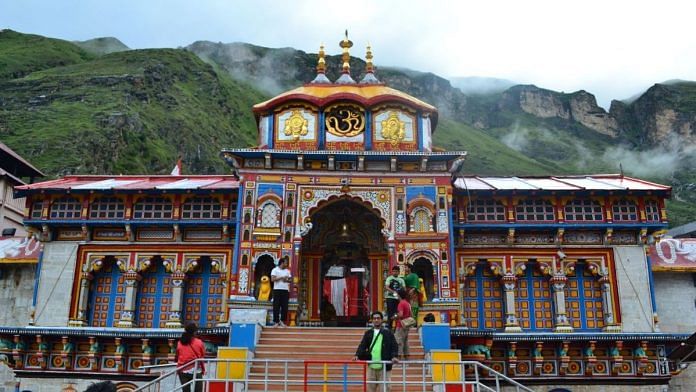New Delhi: The Supreme Court Tuesday advocated a nuanced approach in the Char Dham highway project in Uttarakhand, to strike a balance between the security of the country and environmental concerns that have arisen due to hill cutting for widening roads.
In an indirect reference to the border skirmishes between India and China, a bench led by Justice D.Y. Chandrachud observed orally that the court cannot override defence concerns, particularly in the context of the “contemporary events”.
“All development has to be sustainable, there is no doubt about it. But sustainable development has to be balanced with defence of the nation. We cannot deny the fact we are really in a terrain and altitude where the defence of the nation is extremely important. Can we, therefore, say we will override the concerns of the armed forces or the defence?” noted the bench, also comprising justices Surya Kant and Vikram Nath.
The remarks were made while the court was hearing the Union Ministry of Defence’s application to modify its 8 September 2020 order and allow a seven-metre-wide two-lane road in some parts of the 900-km Char Dham highway project.
In September 2020, rejecting the central government’s contention, the SC had ordered that the road width in the entire ecologically fragile Himalayan region should be 5.5 metres, according to the Union Ministry of Road Transport and Highways’ 2018 guidelines for major roads built in mountainous terrain.
Subsequently, in December 2020, the defence ministry filed its modification application, further deepening the legal imbroglio surrounding the Rs 12,000 crore highway project, at a time when the Narendra Modi government is pushing for its quick completion.
The Char Dham yatra has been one of the Modi government’s flagship projects, and is envisaged to improve road connectivity to the Hindu pilgrimage sites of Yamunotri, Gangotri, Kedarnath and Badrinath, besides also bolstering border infrastructure.
However, the dispute over what should be the width of the road reached the top court after a Dehradun-based NGO filed a petition. As part of this pending case, the defence ministry’s application said the areas falling on the Char Dham yatra route are “highly sensitive” and “critical for movement of security forces, deployment pattern, and mobilisation in case of emergency”.
Also read: Uttarakhand flood puts focus on Rs 12,000-cr Char Dham project, ministry awaits SC order
Court’s predicament
Tuesday was the first time the matter was heard at length on the defence ministry’s application, and the arguments will continue Wednesday.
Attorney General K.K. Venugopal, representing the defence ministry, submitted that the roads under the project are feeder roads and need to be of a certain width to transport personnel and material.
Countering his suggestions, senior advocate Colin Gonsalves, the Dehradun-based NGO’s lawyer, cited the parliamentary expert committee’s report to assert that the Himalayas would not be able to take the road construction.
The court found itself getting drawn into a “critical area”, considering it has been called upon to decide the issue in the context of national security.
“Look at our predicament. If the Centre says it is doing it for tourism, then we understand and we can impose more stringent conditions. But when it is needed to defend the borders, then it is a serious predicament the court has to encounter in cases like this,” the bench remarked.
It said one cannot factually deny the roads cited by the defence ministry are strategic feeder roads to the borders.
“Therefore, the whole notion that border roads are those which are pertinent to the border in a geographical sense may not be the correct way of dealing (with the issue) because feeder roads subserve the border roads and need to be equally upgraded,” the bench added.
To put things in perspective, the bench said it was important to understand that the ministry did not intend to construct a six or eight-lane highway, but has urged to allow a two-lane road.
Can preparedness on other side be ignored?
Upgrading roads is critical to the defence of any country, but the court wondered if it can say ‘we will override the environmental concern because it is defence’.
It asked Gonsalves if the preparedness on the “other side” can be ignored. “At the same time, we have an adversary who has developed infrastructure on the other side of the border,” the bench remarked.
Gonsalves told the bench that if the Himalayas were capable of taking construction work that is happening, then it should be allowed “by all means”. But the recent disasters, including flooding, indicate otherwise.
However, the bench was of the view that flooding or glacier melt is not “just a function of the construction of the roads, but is a wider and more systematic issue”.
“It possibly does not only pertain to India itself, but to countries in the region. It is a product of rapid development taking place across the world,” it said.
“Undoubtedly, Himalayas are young mountains, fragile. The work of any road construction has to be carried out with considerable degree of care. At the same time, can we really say that these concerns which have been expressed before the court to protect the security of the country should just be disregarded by this court? Would we be justified in doing that?” the court wondered.
(Edited by Shreyas Sharma)
Also read: Split in SC panel on Char Dham project, 21 of 26 members are against reducing road width



